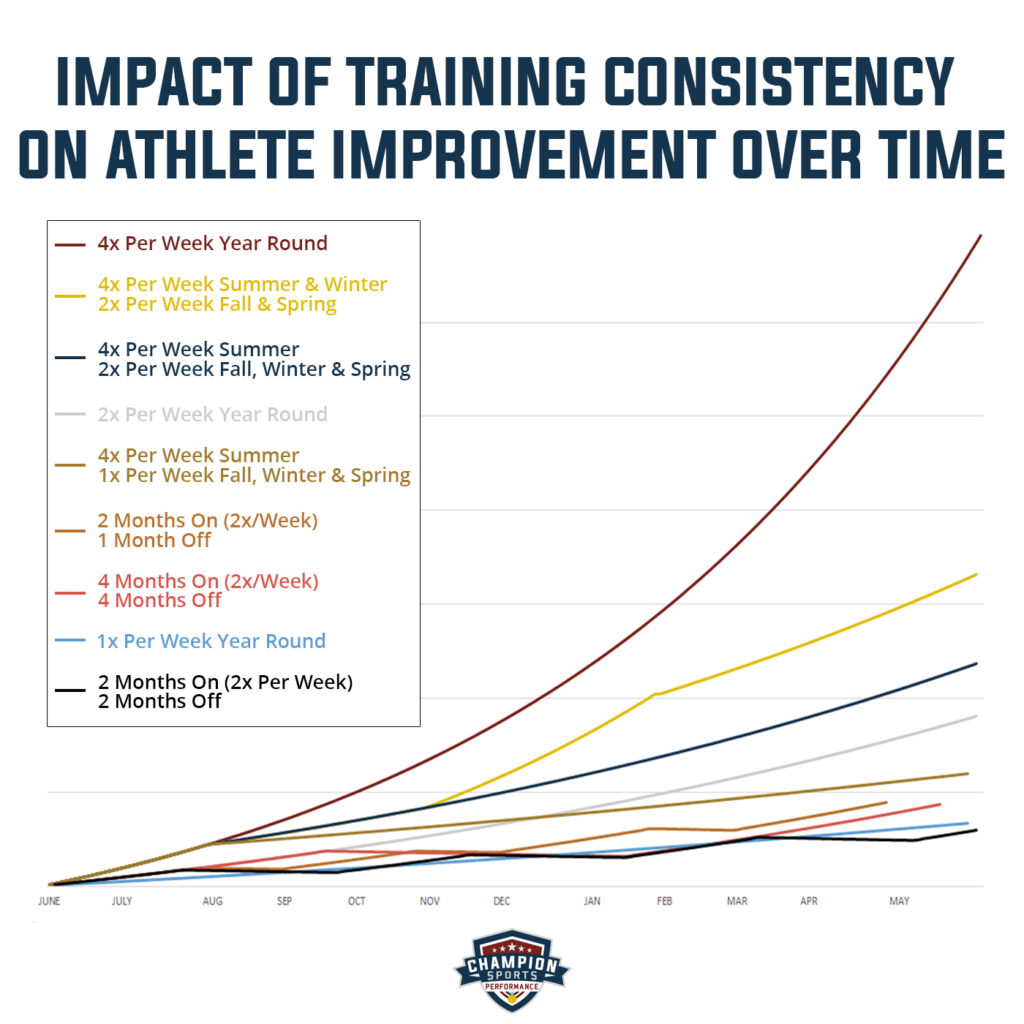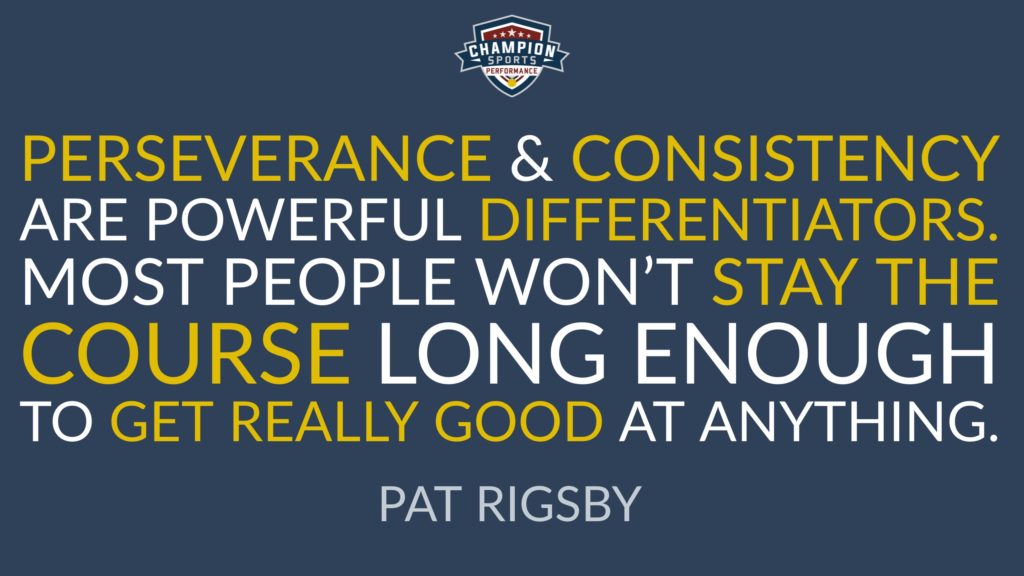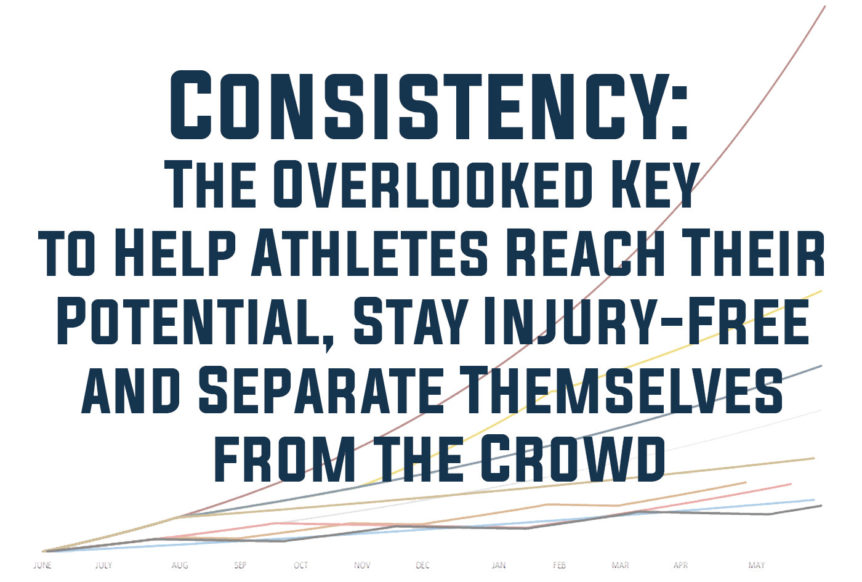An important aspect of our training philosophy is maintaining a big-picture perspective and pursuing improvement over the long-term. When talking with the athletes in our programs we emphasize the importance of taking a long-term perspective when it comes to their development.
We want athletes (and parents and coaches) to understand and embrace the concept of Kaizen. Kaizen is a Japanese concept that encourages the pursuit of continuous small improvements over time, which ultimately add up to very significant growth.
We don’t chase after shortcuts.
We don’t “cram” for tryouts.
We aren’t chasing after the biggest improvement in one night.
We don’t squeeze our training programs into 2-week camps.
We have developed a year-round training plan for our programs because we are coaching our athletes for their long-term benefit to help them discover how much they can improve over the course of their athletic careers, not just in the next few weeks.
As Coach Jim Kielbaso, President of the International Youth Conditioning Association, put it: “You can’t microwave an athlete.”
One of the 6 main pillars of our Champions Code (which hangs just inside our front door and is discussed each week in our sessions) says:
Commit To The Process: Focus now on making small improvements; over time these lead to big gains.
This commitment requires trust in the process and the plan for the training program. This requires patience to allow the athlete to learn new skills. This also requires athletes to give their best effort every time (another pillar of our Champions Code!). Ranging from how to move efficiently, progressing resistance for strength development, learning proper acceleration or top-speed sprinting mechanics, learning how to change direction quickly, to learning proper throwing and hitting mechanics, and more – there are a lot of new skills our athletes are learning and developing.
On top of the trust and patience, committing to the process requires consistency. The process of continually improving at the skills and athletic attributes our athletes are developing requires time and effort to gain traction and see improvement. Mastering and applying those skills takes both time and deliberate repetition.
How much difference does consistency really make?
We encourage our athletes to try to get just 1% better every time they come to train with us. We aren’t looking for a 10% jump in an hour of training. But we are looking for them to become 1% better as an athlete. That might mean they improved in their strength or speed (or both!). Perhaps that means they’ve gotten better at staying focused and applying their best effort on every rep. Perhaps they are making improvements in areas such as being respectful to coaches and teammates and being more receptive to coaching. Maybe it means they’ve gotten better about preparing for training with appropriate fuel, hydration, sleep, and mindset.
Across all those facets, their aim is to get 1% better as an athlete every time they train with us. And if they do that day after day, their improvement compounds and their performance improves significantly.
How does this play out for our athletes?
With the flexibility built into our program, athletes have a broad range of options regarding the frequency of their training throughout the year. Many athletes stick with 2x per week training during their competitive seasons, but ramp up to 4x per week during their off seasons. When schedules are especially tight, some athletes choose to briefly drop down to just 1x per week training. From time to time we see athletes train consistently (2x or 4x per week) for a few months, then take a break for a month or 2.
With all those possible trajectories in mind, we did some calculations. Let’s assume that all of these athletes apply the necessary effort and preparation to improve by 1% every day they train with us.
Let’s also assume that if they are improving 1% every day they are applying that effort in training, it would be pretty generous to say that they would only lose 1% of their overall performance by taking a whole month away from training.
With those assumptions, we can see how each of the various training frequencies impacts their improvement after a year. In other words, we can graph the impact that training consistency has on athletes improvement over time as shown in the graph below.

Interpreting the Outcomes of Different Levels of Consistency
At the top of the graph (shown in dark red) we see the trajectory of an athlete who commits to training 4 days per week throughout the year. Assuming we are just looking at their sports performance training, that comes to at least 16 hours every month dedicated to becoming a better athlete. This athlete’s persistence and consistency have earned them outstanding improvement, with each day building on the one before.
The next highest outcome (shown in yellow, roughly half of the improvement of the top achievement) is an athlete who trained 4x per week during the Summer and Winter Off Seasons, and 2x per week during the Fall and Spring Seasons. Next, we have (shown in dark blue) the athlete who trained 4x per week during the Summer, and then consistently trains 2x per week during the Fall, Winter, and Spring. The fourth highest outcome (roughly 1/3 of the top result, shown in silver) is an athlete who consistently trains 2x per week year-round. This athlete is dedicating 8 hours per month to becoming a better athlete, but their potential improvement is less than half of the athlete who trains 4x per week year-round.
The next five trajectories demonstrate even less consistency, and thus reduced potential improvement at the end of the year. Is the improvement these athletes see better than if they had done nothing? Absolutely! These athletes will end the year considerably ahead of where they started. But the lack of consistency compared to the outcomes in the lines above limits the potential improvement they are able to achieve by the end of the year.
An athlete who dives in with training 4x per week during the summer but then drops down to 1x per week during the Fall, Winter and Spring will have the potential to reach about 75% of the improvement of an athlete who trains 2x per week year-round, and roughly 25% of the improvement demonstrated by an athlete who trains 4x per week year-round.
What Are You Working to Achieve – and Are You On Pace To Achieve It?
The significant impact of consistent, year-round training on an athlete’s performance over the course of their lifetime and competitive athletic career is undeniable. Quite simply, the athletes who are most consistent tend to see the greatest improvements over time.
If you have big goals, yet are only dedicating 4 hours each month (1x per week) to that pursuit, are you on pace to achieve those goals? Perhaps! But it is worth taking a moment to consider the impact that greater consistency could have on the likely improvement you can see in the next year, 2 years, or 4 years.
Consistent Athletes Tend To Be Healthy Athletes
Beyond the simple math, we have observed that athlete health is also closely connected to their consistency. Of all the athletes who have participated in our programs, we’ve observed two trends:
- The athletes who train most consistently tend to be injured less frequently. By ensuring that they build – and maintain – sufficient strength and proper mechanics to withstand the high demands that their sport puts on their body, they are better equipped to perform at a high level with lower risk of injury.
- The athletes who train least consistently (one day per week or training for 1-2 months, then out for several months, then in for a month, etc.) are often dealing with injuries more frequently. These athletes are not only missing the benefits of sustained training to build and maintain the strength needed to perform while staying healthy, but they are often opting to add more competitions, games, tournaments, and leagues instead of training. This takes an even greater toll on their developing bodies, which are less equipped to handle that strain which is sadly a recipe for disaster (or at a minimum, frustration) for many young athletes.
Careful Consideration
Take a look at that graph again. Then consider the following questions:
- At your current pace, does the trajectory you are on match your goals and expectations?
- Are you striking the right balance to achieve your goals while balancing training, school, practices, and games?
- Are you sufficiently preparing your body for the physical demands of your sport to perform at your best and reduce your risk of injury?
- If you are looking to separate yourself from your competition, have you prioritized your training consistency to make that goal a reality?
All of those are important questions to honestly consider.
If you have questions about how to strike the right balance with your training, reach out to us so we can help you navigate those decisions.
Training 4 days or more each week isn’t a fit for every athlete or family in every season. There may be some seasons when even twice per week seems hard to balance. And it is important to find the right balance for your schedule. But at the same time, some athletes and parents may not even realize that they are overlooking the key to helping them reach their potential: Training Consistency.
We can scale your program to fit your schedule, and want to help guide you in establishing the right goals and expectations. Come talk with us so that we can help determine the right approach for you.
To your success,
Coach Chris Stratis


